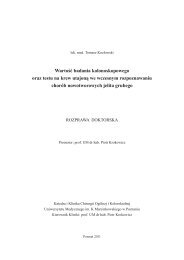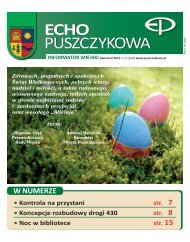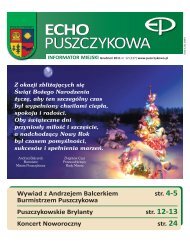MILITARY PHARMACY AND MEDICINE
MILITARY PHARMACY AND MEDICINE
MILITARY PHARMACY AND MEDICINE
You also want an ePaper? Increase the reach of your titles
YUMPU automatically turns print PDFs into web optimized ePapers that Google loves.
© Military Pharmacy and Medicine • 2012 • 4 • 39 – 50bromfenac which, together with their extensivelystudied and clinically effective (not only in ophthalmology)progenitor, diclofenac, are currentlythe most common drugs in this category.A detailed characteristics of ophthalmic NSAIDsis presented below. The first part discusses drugscurrently available in Poland (Indocollyre, Dicloabak,Difadol 0,1%, Naclof, Nevanac, Yellox),while the second part discusses other ophthalmicNSAIDs — both drugs used in the past (Profenal,fenoprofen) and currently used in other countriesAcular/Acular-LS/Acular-PF/Acuvail andOcufen/Ocuflur, Niflan).Indomethacin1-(4-chlorobenzoyl)-5-methoxy-2-methyl-1Hindol-3-aceticacid [C 19H 16ClNO 4; MW 357.80g/mol] — an indole derivative of acetic acid (Fig. 2).Jerzy Z. Nowak: Non-steroidal anti-inflammatory drugs (NSAIDs) in …Indications and dosage [4] (according to Pharmindex-Okulistyka[Ophthalmology], 2012):the drug is intended for use during ophthalmicprocedures and in post-operative settings tocounteract miosis, as well as an anti-inflammatoryagent after cataract removal procedures orsurgeries of the anterior ocular segment and ananalgesic following photorefractive keratectomyon first days following the procedure.The dosage depends on the objective of treatment:• • prevention of miosis during surgical procedures:4 drops on the day before the procedureand 4 drops 3 h before the procedure;••prevention of inflammatory conditions due tocataract surgeries or surgeries in the anteriorocular segment: 1 drop 4-6x/day, starting 24hours before the procedure and continueduntil complete resolution of the symptoms ofinflammation;••treatment of pain after photorefractive keratectomy:1 drop 4x/day on first days after thesurgery.Figure 2: Chemical structure of indomethacin.In the early 1960s, Hart and Boardman were the firstto demonstrate that indomethacin (code no. MK 615)efficiently reduced joint edemas in patients with activerheumatoid arthritis [14]. Two years later (1965), indomethacinwas approved for marketing by the US FDAand became the first non-steroidal anti-inflammatorydrug available. The mechanism of indomethacin’s action,i.e. inhibition of prostaglandin synthesis — wasdescribed by Ferreira, Moncada and Vane in 1971 [15].Indomethacin was also the first ophthalmic NSAIDavailable, and a review of early initial clinical observationsregarding its efficacy in patients with post-operativecystoid macular edema following lens extractionand retinal detachment surgery was published in1984 [16].Indocollyre (Chauvin/Bausch&Lomb) 0.1%ophthalmic drops (1 mg indomethacin/mL),bottle of 5 mL.http://military.isl-journals.comCurrently, Indocollyre is used less and less commonly,as newer ophthalmic NSAIDs, discussedbelow, have been introduced.Earlier, eye drops with trade names of Indoptoland Chibro-Amuno contained 10-fold higherconcentrations of indomethacin (1%; 10 mg/mL);however, solubility and pH-dependent stabilityare significant problems in the case of this agent.Indomethacin itself is practically insoluble in water(while being soluble in alcohol) and was usedin ophthalmic preparations (eye drops) only assodium or tromethamine salts. Indomethacinundergoes decomposition in alkaline solution,while being only slightly soluble in acidic solutions,precipitating when the pH value drops below6. The drug, formulated as ophthalmic suspensionbuffered at pH of 5.6, was stable in thepresence of polyvinyl alcohol (PVA) or hydroxypropylmethylcellulose(HPMC). Therefore, thelater formulation of the drug (0.1% solution) containedPoloxamer-407 as a solvent. Indomethacin’spenetration of the cornea increases significantly(compared to ophthalmic solutions) whenthe drug has the form of oil-based suspension,and particularly emulsion (the difference being[4] All ophthalmic NSAIDs are intended for intraconjunctival administration — thisinformation shall not be mentioned again when describing the use of individualproducts.39
















